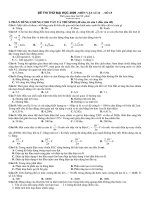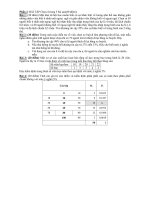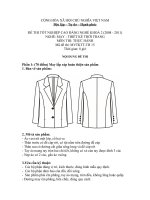PASSAGE 15
Bạn đang xem bản rút gọn của tài liệu. Xem và tải ngay bản đầy đủ của tài liệu tại đây (40.68 KB, 3 trang )
PASSAGE 15
For more than six million American children, coming home after school means com-ing back to an
empty house. Some deal with the situation by watching TV. Some may hide. But all of them have
something in common .They spend part of each day alone. They are called ''latchkey children''. They are
children who look after themselves while their parents work .And their bad condition has become a
subject of concern .
Lynette Long was once the principal of an elementary school .She said,''We had a school rule against
wearing jewalry. A lot of kids had chains around their necks with key attached. I was constantly telling
them to put the key inside shirts. There was so many keys ; it never came to my mind what they meant.''
Slowly, she learned that they were house keys.
She and her husband began talking to the children who had keys. They learned of the effect working
couples and single parents were having on their children. Fear was the biggest problem faced by children
at home alone. One in three latchkey children the Longs talked to reported being frightened. Many had
nightmares and were worried about their own safety.
The most common way latchkey children deal with their fears is by hiding. They may hide in a shower
stall, under a bed or in a closet. The second is TV. They often turn the volume up. It's hard to get statistics
on latchkey children, the Longs have learned . Most parents are slow to admit that they leave their
children alone
Question 1. The phrase ''an empty house'' in the passage mostly means________
A. a house with nothing inside
B. a house with no people inside
C. a house with too much space
D. a house with no furniture
Question 2. One thing that the children in the passage share is that________
A. they all watch TV
B. they all were jewelry
C. they spend part of each day alone
D. they are from single-parent families
Question 3. The phrase ''latchkey children'' in the passage means children who____
A. look after themselves while their parents are not at home
B. close doors with keys and watch TV by themselves
C. are locked inside houses with latches and keys
D. like to carry latches and keys with them everywhere
Question 4. The main problem of latchkey children is that they_______
A. watch too much TV during the day
B. are growing in numbers
C. suffer alot from being left alone
D. are also found in middle-class families
Question 5. What is the main idea of the first paragraph?
A. bad condition of latchkey children
B. children's activities at home
C. how kids spend free time
D. why kids hate going home
Question 6. Why did a lot of kids have chains around their necks with keys attached?
A. schools didn't allow them to wear jewelry, so they wore keys instead.
B. they would use the keys to enter their houses when they came home
C. they were fully grown and had become independent
D. they had to use the keys to open school doors
Page 1
Question 7. What do latchkey children suffer most from when they are at home alone?
A. Fear
B. Tiredness
C. Loneliness
D. Boredom
Question 8. Lynette Long learned of latchkey children's problems by____
A. talking to them
B. visiting their homes
C. interviewing their parents
D. delivering questionaires
Question 9. What is the most common way for latchkey children to deal with fears?
A. talking to the Longs B. hiding somewhere
C. lying under a TV
D. having a shower
Question 10. It's difficult to find out the number of latchkey children because__________
A. they hide themselves in shower stalls or under beds
B. they do not give information about themselves for safety reasons
C. there are too many of them in the whole country
D. most parents are reluctant to admit that they leave their children alone.
ĐÁP ÁN
1-B
2-C
3-A
4-C
5-A
6-B
7-A
8-A
9-B
10-D
LỜI GIẢI CHI TIẾT
Question 1:
Empty house: căn nhà trống vắng, không người ở = no people inside
Question 2:
“But all of them have something in common .They spend part of each day alone” => tất cả lũ trẻ đều có 1
điểm chung là dành một nửa thời gian mỗi ngày ở một mình.
Question 3:
“They are called ''latchkey children''. They are children who look after themselves while their parents
work” => “những đứa trẻ đeo khóa” - cụm từ này chỉ những đứa trẻ tự chăm sóc mình khi bố mẹ đi làm.
Question 4:
“And their bad condition has become a subject of concern.” => vấn đề chính của những đứa trẻ tự chăm
sóc mình như vậy là những tổn thương chúng phải chịu khi ở một mình.
Question 5:
“And their bad condition has become a subject of concern” => ý chính ở đoạn văn 1 chính là tình trạng tồi
tệ của những đứa trẻ phải tự chăm sóc mình khi bố mẹ đi làm.
Question 6:
“Fear was the biggest problem faced by children at home alone. One in three latchkey children the Longs
talked to reported being frightened. Many had nightmares and were worried about their own safety.” =>
nhiều đứa trẻ đeo nhiều dây với chìa khóa ở cổ bởi vì chúng cần có chìa khóa để vào nhà khi trở về nhà.
Question 7:
“Fear was the biggest problem faced by children at home alone”
Question 8:
Page 2
“She and her husband began talking to the children who had keys. They learned of the effect working
couples and single parents were having on their children.” => Long đã nói chuyện với những đứa trẻ phải
ở một mình để hiêu thêm về vấn để của chúng.
Question 9:
“The most common way latchkey children deal with their fears is by hiding. They may hide in a shower
stall, under a bed or in a closet.” => Cách phổ biến nhất của những đứa trẻ đeo khóa khi đối mặt với sợ
hãi là trốn vào đâu đó.
Question 10:
“It's hard to get statistics on latchkey children, the Longs have learned . Most parents are slow to admit
that they leave their children alone.” => rất khó để thống kê số lượng trẻ em đang phải ở một mình vì bố
mẹ chúng thường khơng thừa nhận về việc để con mình 1 mình như vậy.
Page 3









